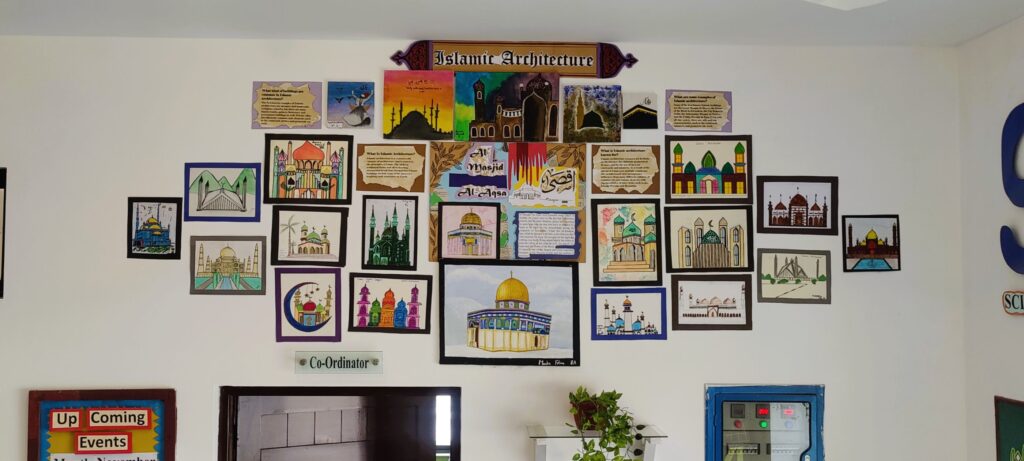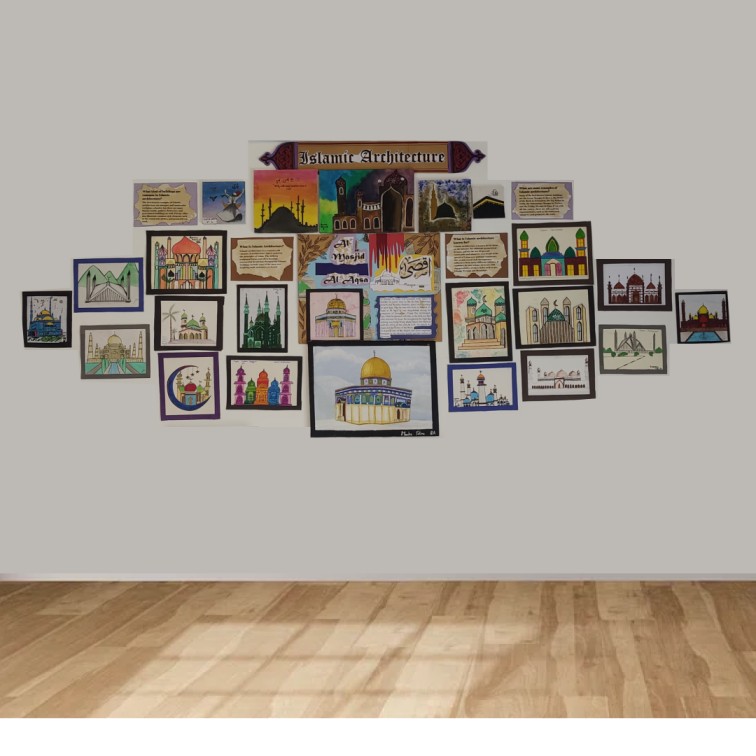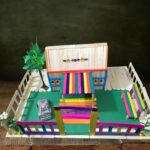The beauty of Islamic architecture lies in its harmony, symmetry, and intricate patterns. From the golden dome of the Al-Aqsa Mosque to the towering minarets of the Blue Mosque, Islamic art has always inspired generations with its beauty. Today, teachers are taking that inspiration into the classroom, helping students explore mosque art, Islamic patterns, and architectural design.
One creative way to showcase this learning is through a student artwork wall. In many schools, teachers design Islamic architecture wall displays, where students’ creations are framed, neatly arranged, and paired with informative posters. This not only beautifies the classroom but also encourages each child to take pride in their work.

The Display: A Wall of Islamic Architecture
In the example above, the wall display is titled “Islamic Architecture.” At the top, a large central headline immediately grabs attention. Below it, a collection of student artwork, mosque sketches, and posters is arranged in a balanced manner, covering the wall like a gallery.
The display includes:
- Main Title Board – “Islamic Architecture” written in bold, decorative font to introduce the theme.
- Student Mosque Drawings – Each with black, purple, or colored borders to highlight. These include famous structures such as the Dome of the Rock, the Badshahi Mosque, and the Taj Mahal.
- Informational Posters – Small print or handwritten notes that answer important questions, such as:
- What is Islamic architecture?
- What are some famous examples?
- What features make it unique?
- Creative calligraphy and patterns – Some of the students’ work includes Arabic calligraphy and geometric designs, blending art with culture.
- Large Centerpiece Artwork – In the lower center, a large piece (e.g., the Dome of the Rock) serves as the central feature.
Together, these elements transform a simple wall into a cultural and educational art gallery.
Step-by-Step: How Teachers Can Make a Similar Wall
If you want to create a wall like this in your classroom, here’s how:
Choose a theme
The teacher chooses Islamic architecture as the theme, focusing on mosques, domes, arches, and minarets. This gives direction and keeps the student’s work cohesive.
Create a central title poster
At the top, place a bold label such as “Islamic Architecture.” Teachers can decorate it with Islamic patterns, borders, and calligraphy.
Collect student artwork.
Ask students to:
- Draw and color famous mosques.
- Create geometric Islamic patterns.
- Create calligraphy inspired by Quranic verses or words such as salutations.
Frame Each Piece
Each student’s work should have a chart paper (black, purple, green, or blue). This makes the display look clean, professional, and consistent.
Add Informative Notes
Print or handwrite short educational texts, such as:
- What is Islamic architecture?
- Why do mosques have domes and minarets?
- What is the role of calligraphy in Islamic art?
- These notes make the wall not only artistic but also informative.
Arrange in a Gallery Style
Place the main poster on top, the largest artwork in the middle, and surround it with smaller framed works and notes. A balanced arrangement makes the wall visually appealing.

Benefits of an Islamic Architecture Art Wall
- Encourages creativity – Students take pride in seeing their work framed and displayed.
- Teaches culture and history – Children learn about Islamic art and mosque design engagingly.
- Inspires other students – A wall like this encourages others to participate in future projects.
- Beautifies school – the classroom or corridor becomes lively and educational.
- Blends learning and art – history, geometry, calligraphy, and creativity all come together.
Ideas to Extend the Project
If you want to expand the project, try adding:
- Small 3D mosque models made of cardboard.
- A calligraphy corner where students practice writing Arabic.
- An art quiz section with short questions about famous mosques.
- Digital QR codes that link to student presentations or videos about Islamic art.
This helps keep the project interactive and educational.
The Role of Teachers in This Project
The teacher plays a key role in guiding students throughout the project. From introducing Islamic architecture to helping organize the final artwork, each step helps students learn artistic discipline and respect for culture.
Teachers can:
- Provide reference images of famous mosques.
- Demonstrate basic geometric pattern drawing.
- Encourage calligraphy experiments.
- Teach about the symbolism behind shapes, balance, and symmetry.
- Lead group discussions on how Islamic design represents unity and harmony.
Watch the Process Come to Life
See Our Islamic Architecture Wall in Action!
- A stunning wall that celebrates student imagination and Islamic beauty
- Intricate geometric patterns, mosque silhouettes, and elegant arabesque designs
- A creative centerpiece featuring teacher-led artistry and framed student masterpieces
Watch how our Islamic Architecture display came to life — from inspired sketches and colorful patterns to a breathtaking wall filled with faith, culture, and creativity. The video captures the artistic process, delicate details, and the joy of students exploring Islamic art through design and decoration.
Witness the transformation — and stay tuned for more inspiring classroom displays that showcase the beauty of student creativity and Islamic art!
Related Blog Posts You Might Like
FAQs
- What is Islamic architecture?
Islamic architecture refers to the style of building that developed under Islamic culture, which includes domes, arches, geometric patterns, calligraphy, and detailed ornamentation. - How can students learn about Islamic art through classroom activities?
Students can explore Islamic art by creating geometric patterns, designing mosque wall art, using symmetry, and incorporating calligraphy into their artwork. Teachers can guide them with examples and creative tasks. - Why is it important to display student artwork in schools?
Displaying student artwork encourages creativity, builds confidence, and encourages other students to participate in art activities. - How can teachers create an Islamic art wall display?
Teachers can create a beautiful wall display by combining a center poster on Islamic architecture, framed student artwork, and brief written information about the art style and design elements of a mosque. - What materials can be used for an Islamic art wall project?
Common materials include colored papers, rulers for creating geometric patterns, calligraphy pens, paints, chart paper, and frames or borders for display purposes.
Final Thoughts
The Islamic Architecture Student artwork Wall is more than just decoration – it’s a celebration of culture, creativity, and learning. By arranging mosque maps, Islamic patterns, and informative notes in a framed gallery, teachers create a living museum within the classroom.
Every student feels proud when they show their work. Every visitor, parent, or teacher who passes by is encouraged. And most importantly, the wall reminds children that art is a bridge between knowledge, culture, and creativity.
So, if you’re planning your next classroom project, try creating a student artwork wall on Islamic architecture — a project that connects the past to the present and inspires young minds to imagine the future.




Pingback: Tile Designing and Radial Patterns Wall Display - 1thousandideas
Pingback: Arabic Calligraphy Student Art Wall: - 1thousandideas
Pingback: Cubism Art by Kids: A Gallery-Style Wall Display - 1thousandideas